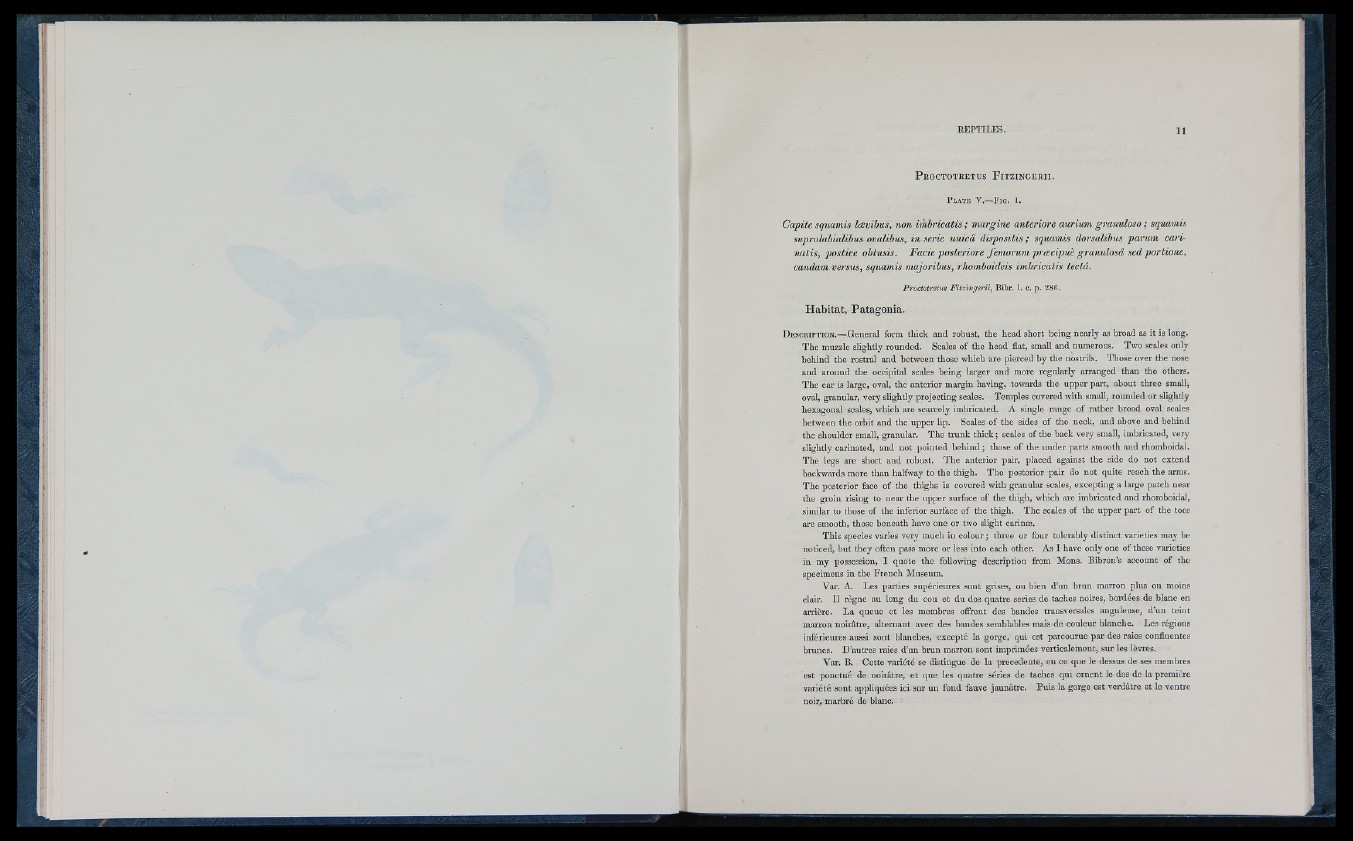
P r o c t o t r e t u s F i t z in g e r i i .
P late V.—F ig . 1.
jIWtìL
iH
t a ,
Capite squaxnis lævibus, non imbricatis ; margine anteriore aurium granuloso ; sqmmis
supralabialibus ovalibus, in serie unicâ dispositis ; squamis dorsalibtis parum carinatis,
postice obtusis. Fade posteriore femorum præcipué granulosâ sed portione,
caudam versus, squamis majoribus, rhomboideis imbricatis teciâ.
Proctotretus Fitzingerii, Bibr. 1. c. p . 286.
Habitat, Patagonia.
D e s c r ip t io n .— Ge n era l form th ic k an d robust, th e h e a d sh o rt b ein g n ea rly as broad as it is long.
T h e muzzle slightly ro u n d e d . Scales o f th e head flat, small an d numerous. Tw o scales only
b eh in d th e ro stra l an d betwe en those which are p ierc ed b y th e nostrils. Those over th e nose
a n d aro u n d th e occipital scales b ein g larg e r an d more re gula rly arran g e d th an th e others.
T h e e a r is large , oval, th e an te rio r margin having, towards th e u p p e r p a rt, about th re e small,
oval, gra n u la r, very slightly p ro jec tin g scales. Temples covered w ith small, ro u n d e d o r slightly
hex ag o n al scales, which are scarcely imbricated. A single ran g e o f ra th e r b road oval scales
betwe en th e o rb it an d th e u p p e r lip. Scales o f th e sides o f th e neck, an d above a n d beh in d
th e shoulder small, g ranula r. T h e tru n k th ick ; scales o f th e back very small, imbricated, very
slightly ca rinated, a n d n o t p o in ted b eh in d ; those o f th e u n d e r p a rts smooth an d rhomboidal.
T h e legs are sh o rt an d robust. T h e a n te rio r p air, plac ed aga inst th e side do n o t ex te n d
backwards more th a n halfway to th e th ig h . T h e posterior p a ir do n o t quite re a ch th e arms.
T h e p o sterio r face o f th e thighs is covered with g ra n u la r scales, exc epting a large p a tc h near
th e gro in rising to n e a r th e u p p e r surface o f th e thigh, which are im b ricate d an d rhomboidal,
similar to those o f th e inferior surface o f th e thigh. T h e scales o f th e u p p e r p a rt o f th e toes
are smooth, those b en e a th have one o r two slight carinæ.
T h is species varies very much in c o lo u r; th re e o r four tolerably d is tin c t varieties may be
n oticed, b u t th ey often pass more or less in to each other. As I have only one o f these varieties
in my possession, I qu o te th e following desc ription from Mons. Bibron’s ac co u n t o f th e
specimens in th e F ren c h Museum.
Va r. A. L e s partie s supérieures so n t grises, ou b ien d’u n b ru n marron plus ou moins
clair. I l règ n e au long d u cou e t d u dos q u a tre series d e taches noires, bo rd é es de blanc en
arrière . L a qu eu e e t les membres offrent des bandes transversales anguleuse, d’un te in t
m a rro n n o irâ tre , a lte rn a n t avec des bande s semblables mais d e couleur b la n c h e . L e s régions
in férieu re s aussi sont blanches, ex c ep té la gorge, q u i est parco u ru e p a r des raies confluentes
bru n e s. D ’autre s raies d’u n b ru n m arron sont imprimé es vertic alement, su r les lèvres.
Va r. B. C e tte v a rié té se distingue d e la p re ced e n te, en ce q u e le dessus de ses membres
e s t p o n c tu é de n o irâtre, e t q u e les q u a tre séries de taches q u i o rn e n t le dos de la première
v a rié té so n t appliquée s ici su r u n fo n d fauve ja u n â tre . P u is la gorge e s t v erdâtre e t le v en tre
noir, m arb ré de blanc.